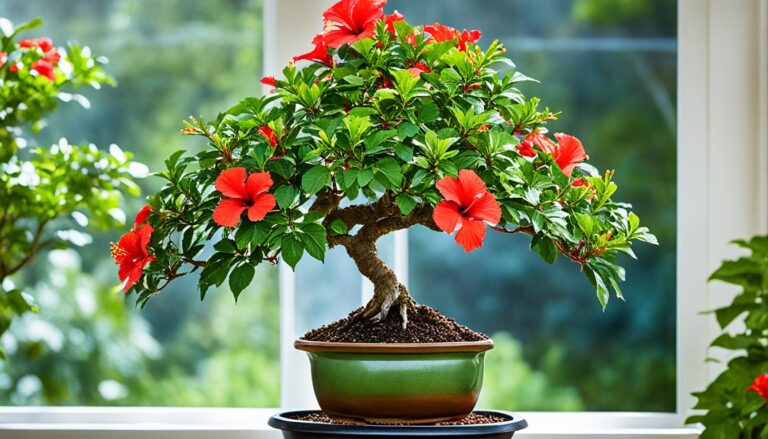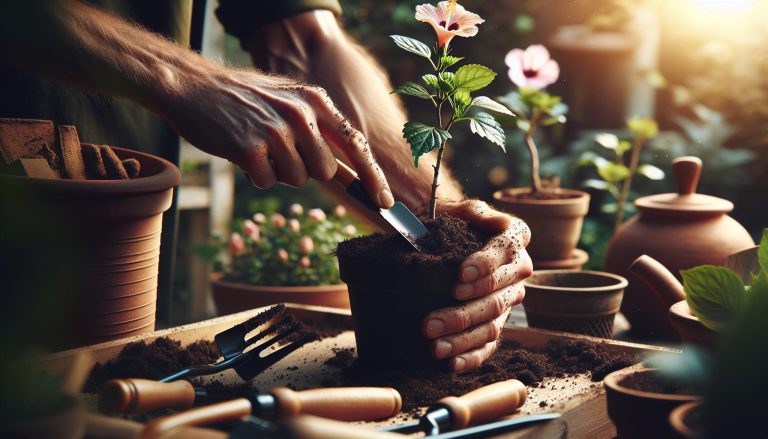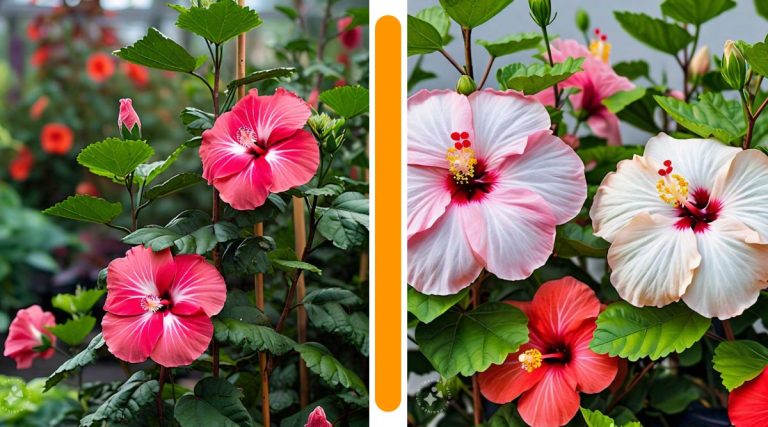Can You Cut Hibiscus Flowers for a Vase? Tips to Make Tropical Blooms Last
Have you ever admired the vibrant beauty of hibiscus flowers in your garden and wondered if you could bring that tropical flair indoors? I’ve often gazed at these stunning blooms, pondering whether they’d make a great addition to my home decor. The good news is, yes, you can cut hibiscus flowers for a vase!
But before you grab your pruning shears, there are a few things to consider. How long will the flowers last once cut? What’s the best time to harvest them? And how can you keep them looking fresh for as long as possible? In this article, I’ll share my expert tips on cutting and caring for hibiscus flowers in a vase, helping you create a stunning floral display that’ll brighten up any room.
Understanding Hibiscus Flowers
Hibiscus flowers are known for their vibrant colors and tropical allure. These stunning blooms come in various shapes and sizes, making them a popular choice for gardens and indoor displays alike.
Types of Hibiscus Plants
Hibiscus plants are divided into two main categories: tropical and hardy. Tropical hibiscus (Hibiscus rosa-sinensis) thrives in warm climates and is often grown as a houseplant in cooler regions. Hardy hibiscus (Hibiscus moscheutos) can withstand colder temperatures and is suitable for outdoor gardens in many parts of the US.
Tropical hibiscus varieties:
- Chinese hibiscus
- Hawaiian hibiscus
- Coral hibiscus
Hardy hibiscus varieties:
- Rose mallow
- Swamp hibiscus
- Dinner plate hibiscus
Bloom Characteristics
Hibiscus flowers are known for their large, showy blooms that can reach up to 6 inches in diameter. These flowers typically have five overlapping petals and a prominent central stamen column.
Key bloom characteristics:
- Vibrant colors: Red, pink, orange, yellow, white
- Short-lived: Most blooms last only 1-2 days
- Seasonal flowering: Peak blooming occurs in summer and early fall
- Sun-loving: Requires full sun for optimal flower production
Hibiscus flowers open in the morning and close or fall off by evening. This short lifespan makes them a unique challenge for cut flower arrangements. However, with proper care and timing, it’s possible to enjoy these tropical beauties indoors for a brief but spectacular display.
Cutting Hibiscus Flowers for Vase Arrangements
Hibiscus flowers can create stunning vase arrangements with proper cutting techniques. I’ll share my experience on the best time to cut these tropical beauties and the right methods to ensure they last as long as possible indoors.
Best Time to Cut Hibiscus Flowers
The optimal time to cut hibiscus flowers is early morning or late evening. Here’s why:
- Cooler temperatures: Flowers are less stressed and retain more moisture
- Higher water content: Blooms are fully hydrated after nighttime recovery
- Longer vase life: Morning-cut flowers typically last 1-2 days longer
- Fully open blooms: Choose flowers that opened that morning for maximum display time
Avoid cutting during midday heat, as flowers will be more prone to wilting and have a shorter vase life.
Proper Cutting Techniques
To maximize the lifespan of cut hibiscus flowers:
- Use clean, sharp pruning shears or scissors
- Cut stems at a 45-degree angle, about 1-2 inches from the base
- Remove leaves that will be below the waterline in the vase
- Immediately place cut stems in room temperature water
- Re-cut stems under water every 2-3 days to maintain water uptake
| Tool | Purpose |
|---|---|
| Sharp pruning shears | Clean cuts, prevent stem damage |
| Bucket of water | Immediate hydration post-cutting |
| Floral preservative | Extend vase life, inhibit bacteria growth |
Remember, hibiscus flowers typically last 1-3 days in a vase. To prolong their beauty:
- Change vase water daily
- Keep arrangements away from direct sunlight and heat sources
- Mist flowers lightly to maintain humidity
- Remove spent blooms promptly
By following these techniques, you’ll create captivating hibiscus arrangements that bring a touch of the tropics indoors.
Preparing Hibiscus Flowers for Display
After cutting hibiscus flowers, proper preparation is crucial for maximizing their vase life and beauty. Here’s how to clean, trim, and prepare your hibiscus blooms for stunning indoor displays.
Cleaning and Trimming the Stems
To prepare hibiscus stems for vase display:
- Rinse stems under cool water to remove dirt and debris
- Trim 1-2 inches off the bottom of each stem at a 45-degree angle
- Use sharp, clean pruning shears to make clean cuts
- Remove any leaves that will be below the waterline in the vase
- Place stems in clean, room temperature water immediately after trimming
Trimming the stems at an angle increases the surface area for water uptake, helping the flowers stay hydrated longer. I’ve found that re-cutting the stems every 2-3 days can significantly extend the flowers’ vase life.
Removing Excess Foliage
Removing excess foliage from hibiscus stems serves several purposes:
- Reduces bacterial growth in the vase water
- Directs more energy to the flower bloom
- Creates a cleaner, more focused floral display
To remove excess foliage:
- Gently strip off leaves from the bottom 2/3 of each stem
- Leave a few upper leaves intact for a natural look
- Be careful not to damage the stem while removing leaves
- Discard removed foliage or add to your compost bin
By following these steps, you’ll create a cleaner, longer-lasting hibiscus flower arrangement. Remember to handle the delicate blooms gently throughout the process to avoid damaging them.
Preserving Hibiscus Flowers in a Vase
Hibiscus flowers can last up to 3 days in a vase with proper care. Maximizing their vase life requires attention to water conditions, temperature, and light exposure.
Ideal Water Conditions
For optimal hibiscus preservation, use room temperature, clean water. Fill the vase 2/3 full to ensure adequate hydration without drowning the stems. Add 1/4 teaspoon of sugar per quart of water to provide nutrients. Change the water every 2 days to prevent bacterial growth. Avoid using tap water with high chlorine content; opt for filtered or distilled water instead. To further extend vase life, mix in a commercial flower preservative following package instructions.
Temperature and Light Requirements
Hibiscus flowers thrive in moderate temperatures between 65-75°F (18-24°C). Keep them away from direct sunlight, heating vents, and air conditioning units. Place the vase in a spot with indirect, bright light for 6-8 hours daily. At night, move the flowers to a cooler area (around 60°F or 15°C) to slow down the aging process. Avoid drafty areas that can cause rapid temperature fluctuations. If the room is warm, mist the flowers lightly with water once a day to maintain humidity and prevent wilting.
Extending the Life of Cut Hibiscus Flowers
Cut hibiscus flowers can brighten up any room, but their beauty is fleeting. With the right care, you can extend their vase life and enjoy their tropical allure for longer.
Using Floral Preservatives
Floral preservatives are essential for maintaining cut hibiscus flowers. These solutions contain sugar for nutrition, acidifiers to lower pH, and biocides to prevent bacterial growth. Here’s how to use them effectively:
- Mix the preservative: Follow the package instructions carefully.
- Use clean vases: Sanitize vases before adding the solution.
- Refresh regularly: Replace the preservative solution every 2-3 days.
- Commercial options: Look for products specifically designed for tropical flowers.
- DIY alternative: Mix 1 teaspoon sugar, 1 teaspoon bleach, and 2 teaspoons lemon juice per quart of water.
Remember, floral preservatives can’t work miracles, but they’ll give your hibiscus blooms the best chance at a longer vase life.
Regular Maintenance Tips
Maintaining cut hibiscus flowers requires daily attention. Here are some practical tips to keep your blooms looking fresh:
- Trim stems daily: Cut 1/4 inch off the stems at a 45-degree angle each morning.
- Remove wilted petals: Pluck off any faded or browning petals promptly.
- Mist flowers: Lightly spray the blooms with water to maintain humidity.
- Avoid heat sources: Keep the vase away from direct sunlight, heating vents, and appliances.
- Night care: Move the flowers to a cool spot overnight to slow aging.
Pro tip: I’ve found that hibiscus flowers respond well to a quick dip in cool water every other day. This helps rehydrate the petals and can perk up drooping blooms.
By following these maintenance tips, you’ll maximize the lifespan of your cut hibiscus flowers, potentially extending their beauty for up to 5 days.
Conclusion
Cutting hibiscus flowers for a vase is a great way to enjoy their beauty indoors. With proper care and attention you can extend their vase life significantly. Remember to use clean water treat the stems and provide optimal conditions. While they may not last as long as some other cut flowers hibiscus blooms can still brighten your home for several days. By following the tips outlined in this guide you’ll be well-equipped to make the most of your cut hibiscus flowers and create stunning floral displays that capture the essence of tropical elegance.







